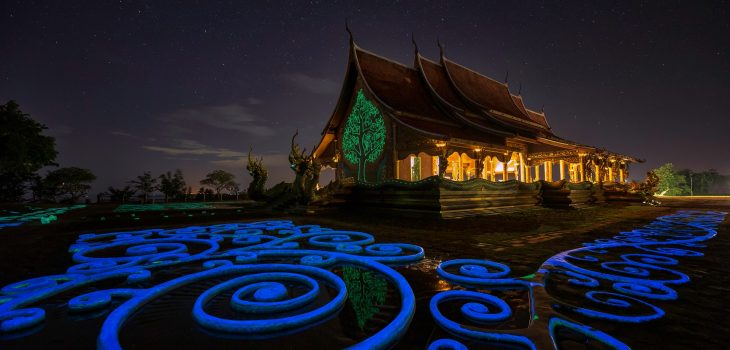Luminescent and chromatic paints for walls, building facades and surfaces


Luminescent (fluorescent, glowing under UV and glowing in the dark) and chromatic (thermochromic, hydrochromic, photochromic) for walls, building facades and surfaces.
In the era of continuous search of surprising and effective architectural and finishing solutions, SPLinx meets the expectations from the market by offering probably the most professional and comprehensive portfolio of products and services related to glow-in-the-dark, fluorescent and invisible fluorescent (glowing under UV) paints. Decorating of architectonic and city spaces with such effective paints enriches them with unusual, expressive, sometimes even a little bit surreal, surprising and interactive ingredients.
Glow-in-the-dark (phosphorescent) paints enable the designer to build a sort of tension and a dialogue between the spectator and a space. Elements of architecture change under natural cycles of day and night. The paints remain almost completely transparent during the day, and in the night conditions or during the blackout they begin glowing with their own light in green, yellow, blue, red, orange or purple. A building facade which charges with light during the day and glows after dark; a ceiling shining in the night like a star-studded sky; elements of pavement „illuminating” the way for pedestrians, glow-in-the-dark ornaments, elements of decorations or costumes. With the help of phosphorescent paints, a creator can light up their nighttime surroundings both indoors and outdoors.
Elements covered with the paint, transparent in the daylight, after turning off the light and turning on the UV lamps (so-called ‘blacklight’), unveils the hidden world oozing with a richness, brightness and purity of colours. This way, it is possible to hide content visible only in the blacklight. Paint which glow under UV come in many colours: from purple, through intensive red, orange, yellow, chartreuse, green, blue, and even white. Having this colour palette at our disposal, we can create really colourful images. It is important to note that these paints are completely transparent or milky white in the ordinary light. They reveal a real blaze of colours only after turning on the UV lamp.
Another example of luminescent paints are fluorescent paints, glowing with bright, pure, neon glow. They are used most commonly at places which in particular are supposed to attract attention, attract the spectator with their brightness, expressiveness and incredibly pure hue. Fluorescent coatings can be seen in the clubs, during spectacular events, at theatres and dance halls. Energetic, intensive colours are intended to attract the attention of the spectator; they scream to them and encourage to enjoyment. Fluorescent paints are equally often used for warning and information purposes. Their distinctive colour makes the spectator focus the attention on them. The spectator is somewhat forced to take note and analyse the message presented to them this way.
Very interesting and innovative effects can be obtained thanks to chromatic paints, especially thermochromic, photochromic or hydrochromic one. Thermochromic paints change colour under the influence of temperature change. A designer is able to shape the image depending on the thermal conditions of the surroundings, colour it when it is cold, and discolour it when it is hot. Surfaces may react to the heat of a human body or other temperature sources, thermochromic floors with footprints remaining on them, walls reacting to the touch, ice or warm air, building facades with thermochromic coatings, which change colours under the warmth of sunrays, ceramic bathroom tiles or floor tiles which change colour when exposed to warm or cold water, heaters changing colours after turning the heating on. By designing architectural devices with the help of thermochromic paints, a user plays a kind of a game with the installation coated with such paint, using available means of temperature change such as the heat of a human body, heating devices, coolness of the ice, etc.
Spectacular visual effects can be achieved with the use of photochromic paints. Completely transparent paints, which become coloured under the influence of a solar radiation (or that of a UV lamp), showing visual elements only after exposure to the light. An architect can create facades changing their colours when the first sunrays hit them, elements of installations providing information only when the sunlight shines on them, warning installations e.g. alarming when the recommended doses of UV light falling on the surface are exceeded, natural decorative elements such as leaves or vines entwining facades and ‘waking up to life’ together with the rising sun.
Hydrochromic paints, changing colour after contact with water or moisture, can bring inspiration to architects who shape city spaces. When the road surface or a pavement are dry, they seem bland, colourless, dull and monotonous, but after a rainfall, these elements can change to vibrant images with vivid colours and colourful ornaments. This way, it is possible to shape also spaces where the water is a source of entertainment or rest, such as swimming pools, saunas, foumtains etc. When the water reaches the surfaces coated with hydrochromic paint, it will transform them, giving them a completely different character, changing their colour, shade, turning the coated object into something completely different or adding to it surprising and message-changing complementations.
You can find the original article here:
https://www.architekturaibiznes.pl/farby-luminescencyjne-i-chromatyczne,6911.html



